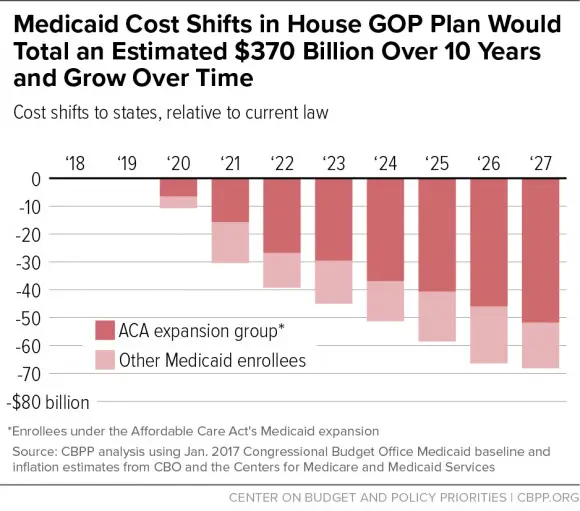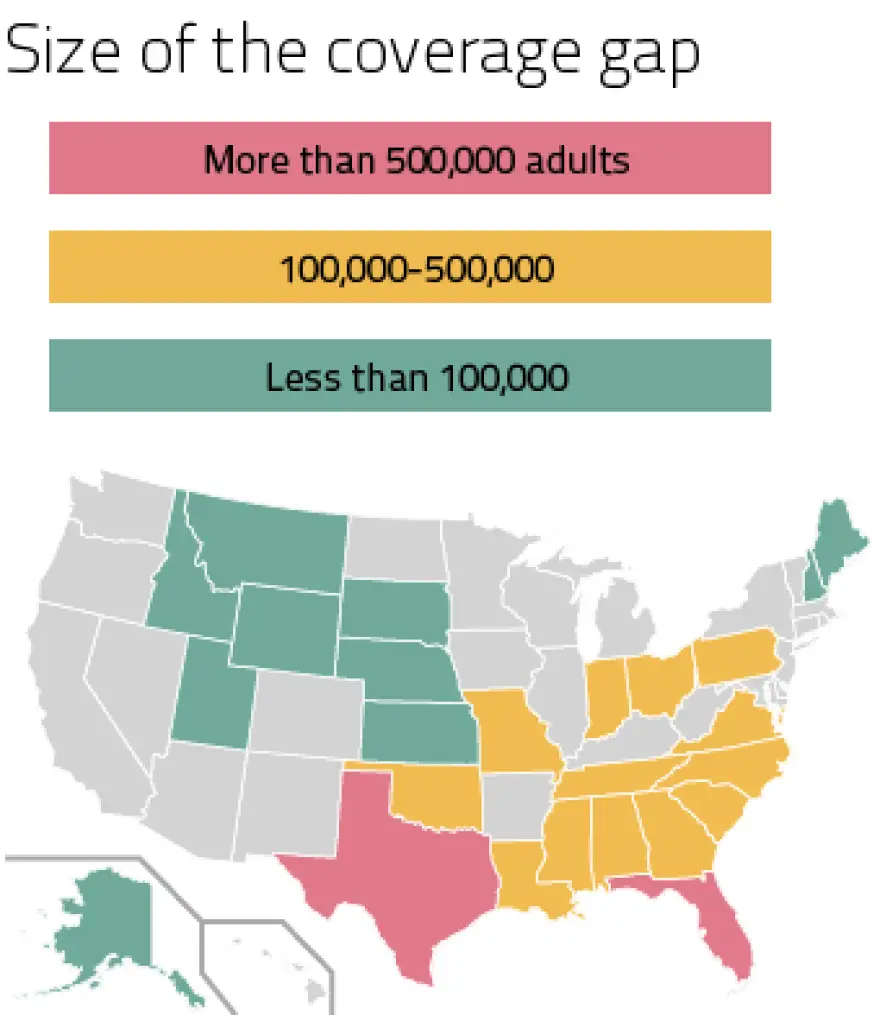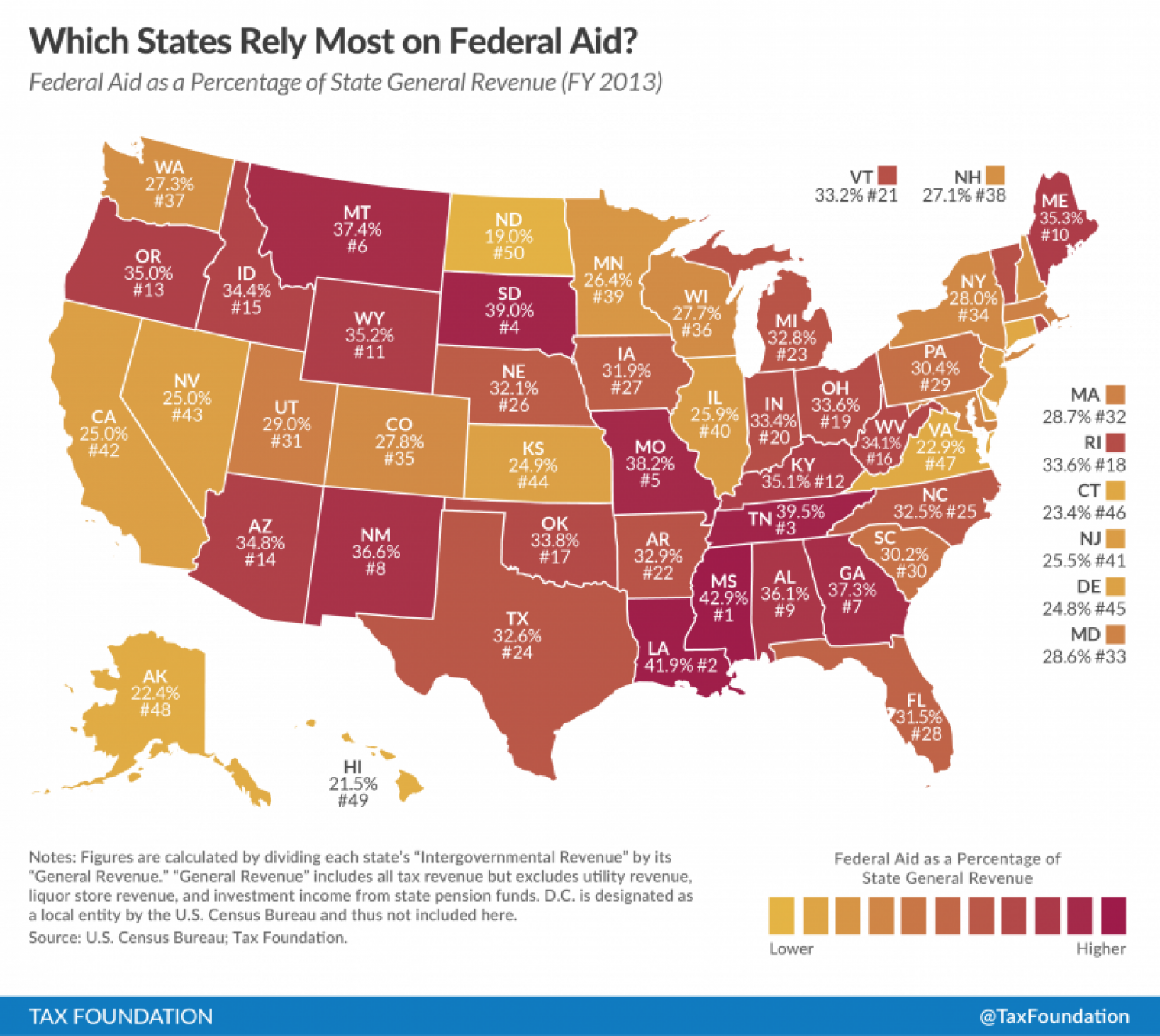Children’s Health Insurance Program
The Children’s Health Insurance Program is a public healthcare program for low-income children who are ineligible for Medicaid. CHIP and Medicaid are related programs, and the former builds on Medicaid’s coverage of children. States may run CHIP as an extension of Medicaid, as a separate program, or as a combination of both. Like Medicaid, CHIP is financed by both the states and the federal government, and states retain general flexibility in the administration of its benefits.
CHIP is available specifically for children whose families make too much to qualify for Medicaid, meaning they must earn incomes above 138 percent of the federal poverty level, or $33,948 for a family of four in 2017. Upper income limits for eligibility for CHIP vary by state, from 175 percent of the federal poverty level in North Dakota to 405 percent of the FPL in New York. States have greater flexibility in designing their CHIP programs than with Medicaid. For instance, fewer benefits are required to be covered under CHIP. States can also charge a monthly premium and require cost sharing, such as copayments, for some services the total cost of premiums and cost sharing may be no more than 5 percent of a family’s annual income. As of January 2017, 14 states charged only premiums to CHIP enrollees, while nine states required only cost sharing. Sixteen states required both premiums and cost sharing. Eleven states did not require either premiums or cost sharing.
Example Of A Medicare Tax Bill For A High Earner
The total tax bill for Medicare that could be paid by a high-income taxpayer could look something like this:
Jerry is single and has inherited several pieces of land that produce oil and gas income at the wellhead. He also works as a salesman for a local technology company and earned $225,000 of 1099 income this year. His oil and gas royalties for the year total $50,000, and he also realized capital gains of about $20,000 from the sale of stock.
Enhanced Federal Medical Assistance Percentages
Enhanced matching rates are similar to FMAP but are taken one step further. They increase the percentage of costs paid by the federal government for certain services. The minimum enhanced FMAP for Fiscal Year 2020 is 76.50. The services covered by enhanced matching rates include but are not limited to:
The Affordable Care Act increased the enhanced FMAP for states from October 1, 2015 through September 30, 2019. It did so by 23 percentage points but did not allow any state to exceed 100%. For Fiscal Year 2020, the enhanced matching rates will be lower. The Healthy Kids Act will allow an increase in the enhanced FMAP by 11.5%, again not to exceed 100% total.
The services covered by enhanced matching rates are seen as valuable because they may help to decrease the burden of healthcare costs in the future. In that way, paying more money upfront is seen as a worthy investment.
You May Like: How To Check Medicaid Status Ny
Disproportionate Share Hospital Payments
Medicaid is not exactly known for being generous when it comes to paying for health care. According to the American Hospital Association, hospitals are paid only 87 cents for every dollar spent by the hospital to treat people on Medicaid.
Hospitals that care for more people on Medicaid or for people that are uninsured, in the end, are reimbursed far less than facilities that operate in areas where there are more people covered by private insurance. Between 2000 and 2018, at least 85 rural hospitals closed their doors to inpatient care due to low reimbursement rates and other financial concerns.
To even out the playing field, Disproportionate Share Hospital payments came into effect. Additional federal funds are given to the states to divide amongst eligible hospitals that see a disproportionate number of people with little to no insurance. The idea was to decrease the financial burden to those facilities so that they could continue to provide care to individuals with low incomes.
Different formulas are used to calculate federal DSH funding for each state. These formulas take into account the prior year’s DSH allotment, inflation, and the number of inpatient hospitalizations for people on Medicaid or who are uninsured. DSH payments cannot exceed 12% of the state’s total Medicaid medical assistance expenditures for any given year.
Constraints And A Lack Of Flexibility

State Medicaid programs often complain that the federal government sets too many restrictions on how Medicaid monies may be used. The reason why Medicaids health results are so dismal is that the outmoded 1965 Medicaid statute sets a laundry list of limits on the capacity of states to run their Medicaid programs, Forbes editor Avik Roy said in an opinion piece published in 2017.
Republicans like Ryan have long advocated changing Medicaid into a block grant system. The federal government would provide a set amount to each state under this scheme. Eligibility, benefits, and payments to providers might then be left up to individual state governments. Proponents of the idea claim it will allow states greater leeway to adapt Medicaid to the needs of their citizens.
But the existing Medicaid program provides considerable leeway through exemptions of federal requirements. This allowed Arkansas to meet its Affordable Care Act coverage expansion goals without expanding Medicaid. The KFF reports that 58 exceptions have been granted to 45 states so far, with a further 26 waivers for 21 states still in the pipeline.
A more serious issue is that most block grant ideas would drastically reduce the amount of money given to states for Medicaid. One of Ryans plans, for instance, would have resulted in a 75% reduction in government expenditure on Medicaid, CHIP, and health care subsidies by 2050, according to an estimate conducted by the Congressional Budget Office in 2012.
You May Like: How To Get A Medicaid Card Replacement
How Does Medicaid Work
It wasnt until an amendment to the Social Security Act in 1965 that the Medicaid program came into existence. The law has been revised and expanded several times over the years by Congress, most recently in 2010 with the passing of the Affordable Care Act , sometimes known as Obamacare.
Now more than ever, low-income individuals and families must rely on Medicaid to fund their medical expenses. In its absence, millions of Americans would be without health coverage.
How Did The Affordable Care Act Change Medicaid
Medicaid plays an even more important role in insuring low-income Americans due to the Affordable Care Act. As noted, the ACA provides coverage for poor and low-income adults by expanding eligibility for Medicaid to 138 percent of the poverty line. As of April 2020, 35 states plus the District of Columbia have implemented the Medicaid expansion to serve poor and low-income adults. By 2029, 14 million more low-income adults will have enrolled in Medicaid and gained access to affordable comprehensive health coverage due to the ACA, CBO estimates.
The expansion is a very good financial deal for states. After picking up all expansion costs for the first three years, the federal government now pays 90 percent of expansion costs on a permanent basis. And by greatly reducing the number of uninsured, the expansion will save states and localities substantial sums on uncompensated care for the uninsured. Some expansion states have also experienced savings in mental health programs, criminal justice systems, and other budget areas.
Also Check: Does Medicaid Pay For Nursing Home Care
Use Of Expensive Services
In 2016, the NEJM published a follow-up research to the one published in 2013. Findings showed that once eligible for Medicaid, patients sought medical attention in a variety of locations, not just ERs .
They frequently visited the ER for issues that might have been handled at a cheaper doctors office. According to its detractors, Medicaid promotes wasteful spending on excessive medical procedures.
But this conclusion is at odds with the results of other research. Health Affairs released research in 2016 that compared emergency department visits with primary care visits before and after Medicaid expansion in Kentucky and Arkansas. Statistical analysis revealed that both values had dropped. They declined much more in Kentucky, where Medicaid was extended, than in Arkansas, where private health insurance was made more widely available.
Although fewer patients in the Health Affairs survey reported using the ED as their primary source of treatment, more patients said they did so when they couldnt get in with a primary care physician. The authors reasoned that the reason was probably elevated customer demand. Wait times at physicians offices increased when Medicaid was made available to more people.
Chip As Medicaid Expansion
States that operate their CHIP as an expansion of Medicaid use forms CMS-37 and CMS-64.
Administrative costs associated with CHIP programs operated as an expansion of a state Medicaid program may also be included on the forms CMS-21 if the state opts to claim Federal Financial Participation at the enhanced Federal Medical Assistance Percentage.
Read Also: Medicaid Ga Number Customer Service
Hospital Insurance Trust Fund
How is it funded?
- Payroll taxes paid by most employees, employers, and people who are self-employed
- Other sources, like these:
- Income taxes paid on Social Security benefits
- Interest earned on the trust fund investments
- Medicare Part A premiums from people who aren’t eligible for premium-free Part A
What does it pay for?
- Medicare Part A benefits , like inpatient hospital care,skilled nursing facility care,home health care, andhospicecare
- Medicare Program administration, like costs for paying benefits, collecting Medicare taxes, and fighting fraud and abuse
Medicare And Medicaid Costs
Medicare is administered by the Centers for Medicare & Medicaid Services , a component of the Department of Health and Human Services. CMS works alongside the Department of Labor and the U.S. Treasury to enact insurance reform. The Social Security Administration determines eligibility and coverage levels.
Medicaid, on the other hand, is administered at the state level. Although all states participate in the program, they aren’t required to do so. The Affordable Care Act increased the cost to taxpayersparticularly those in the top tax bracketsby extending medical coverage to more Americans.
According to the most recent data available from the CMS, national healthcare expenditure grew 9.7% to $4.1 trillion in 2020. That’s $12,530 per person. This figure accounted for 19.7% of gross domestic product that year. If we look at each program individually, Medicare spending grew 3.5% to $829.5 billion in 2020, which is 20% of total NHE, while Medicaid spending grew 9.2% to $671.2 billion in 2020, which is 16% of total NHE.
Recommended Reading: Anthem Blue Cross Blue Shield Medicaid Customer Service Number
Overview Of Medicaid Financing
Each states Medicaid expenditures for healthcare services are matched by federal funds according to various formulas. The formula that governs the majority of government funding takes into account differences in per capita income among the states and is called the federal medical assistance percentages . The FMAP ranges from a minimum of 56 percent in wealthier states such as California to 84 percent in Mississippi. The matching structure provides states with resources that automatically adjust for demographic and economic shifts, healthcare costs, public health emergencies, and natural disasters.
In addition to funds governed by the FMAP, the federal government provides enhanced matching rates for select services, providers, or groups of beneficiaries. The most prominent example stems from the Affordable Care Act , which expanded the Medicaid program to cover individuals with incomes up to 138 percent of the poverty level the federal government covers nearly all the cost of coverage for the expansion population.
Remaining Medicaid expenditures are referred to as the nonfederal share, and federal law requires that states finance at least 40 percent of their share of total Medicaid expenditures through state funds. The remaining 60 percent of the nonfederal share can come from other state funds including funding transferred from local governments or revenue collected from provider taxes and fees.
What’s The Difference Between Medicaid And Medicare

Medicare is a federal program that provides health coverage if you are 65+ or under 65 and have a disability, no matter your income. Medicaid is a state and federal program that provides health coverage if you have a very low income. … They will work together to provide you with health coverage and lower your costs.
Read Also: Medicaid Doctors In Mckinney Tx
Why Do We Contribute To Medicare
Why Do You Have to Pay a Medicare Tax? The Medicare tax helps fund the Hospital Insurance Trust Fund. It’s one of two trust funds that pay for Medicare. The HI Trust Fund pays for Medicare Part A benefits including inpatient hospital care, skilled nursing facility care, home health care and hospice care.
Who Is Eligible For Medicaid
For the first few decades of the programs existence, Medicaid exclusively covered those who were already receiving other forms of government assistance, such as SSI or child welfare. Congress has steadily increased the programs aid allocation throughout the years.
Moreover 68.8 million Americans had health insurance through Medicaid as of July 2020, according to Medicaid.gov. About one-fifth of the population is enrolled in the program, per KFFs estimates.
Prior to 2010, Medicaid coverage was restricted to individuals of specific demographics. All those in need, whether old or young, pregnant or not, able-bodied or not, or from families with little financial resources, fell into this category. Medicaid coverage was expanded for all non-elderly people with incomes up to 138% of the federal poverty threshold in 2010 . It was no longer necessary for individuals to fall into a specific category in order to qualify for insurance.
A court, however, said in 2012 that states were not compelled to expand their Medicaid programs if they did not want to. HealthInsurance.org reports that at this time, 14 states have chosen not to participate in the expansion. People in these jurisdictions may still need to be part of a certain group in order to get medical services.
Also Check: Medicaid And Medicare Differ In That
Overview Of Medicare Funding
Medicare is financed through several different sources. Medicare Part A covers hospital services, but gets 89% of tax revenues from payrolls. Medicare Part B coverage is financed by the government 74% of all revenue, which relates to outpatient care. General revenues are revenue generated by the government from government revenues or other sources for government programs.
Medicare Part D is an optional benefit that covers prescription medications costs and is financed mostly by general revenues of 77%. Medicare Part C â also referred to as Medicare Advantage â is funded through Medicare Parts A, C or D as well as monthly premium pay.
Ohio: Offsetting Some But Not All Costs
Ohios experience differs to some degree. Its official savings estimates amount to only 24 percent of the cost of expansion in FY2021. While this estimate does not fully capture every dollar of savings, it does suggest that savings may be lower in some states.
Ohio funds Medicaid expansion with revenues from two health care taxes tied to expansion. These taxes are expected to generate $248 million in FY2021, or 46 percent of the states share of expansion costs. Combined, these factors offset 70 percent of the cost of expansion. This means that, as of FY2021, Ohio expects to pay 3 percent of the total cost of expansion. While uncounted savings and/or tax revenues from economic impacts may shrink the gap, the Ohio experience suggests that some states may face a marginal cost from expanding Medicaid.
Summary of Fiscal Impacts of Medicaid Expansion in OhioRecommended Reading: Pediatric Dentist That Accept Medicaid In Jacksonville Fl
So Everyone Who Works Pays For Medicare
Medicaid is paid for by income taxes and not payroll taxes. Most of this comes from federal income taxes and a portion also comes from state income taxes. Herein lies the big difference between Medicare funding and Medicare funding everyone pays for Medicare but you only pay for Medicaid if you pay income taxes and income tax revenues mostly come from the wealthy. This is because low income workers fall below the threshold that they have to pay income tax, in fact, 45% of American households paid no federal income tax in 2015. The highest earning 20% of Americans paid an average of $50,000 in federal income taxes that equates to 87% of all income tax received by the federal government. The top 1% of Americans paid 44% of all income tax received by the federal government. And the top 0.1% of Americans paid 20% of all income tax received by the federal government.
What Happens When Medicare Part A Runs Out Of Money
The trust fund for Medicare Part A will be able to pay full benefits until 2026 before reserves will be depleted. … If the reserves run out for the Hospital Insurance Trust Fund, then the program’s income should be able to cover 91% of scheduled benefits. Medicare Part A covers hospital care for enrollees.
Also Check: Chiropractors That Accept Medicaid In Louisiana
What Percentage Of The National Debt Is Social Security
As for Social Security, combined spending is projected to generally increase from its current level of 5.1 percent of GDP to a peak of 6.2 percent for 2077, and then decline to 5.9 percent by 2095. The government collects and maintains funds supporting the Social Security and Medicare programs in trust funds.
How Is Medicare Part D Funded

77% of Medicare D spending is generated by revenues. A third of the funding comes through a beneficiary-paid premium program, the rest comes from payments to state-funded individuals whose low income qualifies for Medicare. Part D of Medicare provides optional coverage that allows patients under Original Medicare to purchase prescription drugs from their own health care providers. Private insurers administer Part D drug plans, which charge beneficiaries premiums, deductibles or copays as deductibles.
Don’t Miss: Is My Medicaid Still Active
